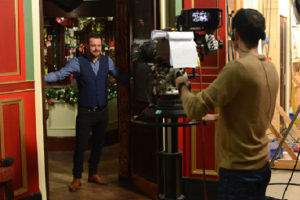Mike Jordan
Watching via Sky on the BBC1 HD on a Panasonic plasma, it looks as if all the pre-recorded bits using old cameras in the Elstree studios are upconverted whereas the “live” bits (the parts with the #EElive hashtag) are shot presumably with a scanner at real HD and actually looks like it?
Also quite a difference between audio quality between them.
(Click on the picture below to see a larger or clearer version of this picture:
Click the “X” button (top right) to close the newly opened picture.)

Jeff Booth
I would imaging the pre recorded studio inserts is XDCam (and compressed) whereas the live stuff probably isn’t (as much).
Watching uncompressed HD is like looking through a window. I would imagine the quality of transmitted BBC1 HD is about the same perceived quality as the output of a SD studio in the 1980s/1990s. Freeview is just so horribly compressed these days (I would be surprised if it’s more than 2Mb/sec) that it is unwatchable. Nothing will change until enough viewers complain.
Dave Plowman
Of course. Allows them to launch ‘super HD’ at some point in the future.
And plenty of history for this. DAB started out being reasonable with just about adequate data rate, and they reduced it to the point where many find it unacceptable.
Jeff Booth
The story about Emperors and new clothes springs to mind.
UHD (or 4K) is just the start. The human eye can only resolve about 2000 pixels horizontally so in order to truly resolve 4K you have to stand about 4 inches (yes inches) from the screen.
4K has 4 times the resolution of 35mm. Feature films are mastered in uncompressed 4K for this very reason. Currently the CGI can only be rendered at 2K. 4K should really be for football stadiums and large arenas. Never for the home. Unfortunately that is where it will make the most money. 8K is only just around the corner.
The real reason for these resolutions is that you can highly compress them and still get a picture at the home. The home viewer has never seen good quality pictures on their TVs since analogue was turned off and CRTs became obsolete.
David Denness
I am informed by colleagues in USA that The Superbowl and other similar major sports events are all now shot in 4K. This enables digital zooming in to action on replays without perceived picture degradation by the time it reaches the viewer.
Jeff Booth
4K in POST makes perfect sense. But as soon as there is 16K+, directors will just have huge wide, locked off shots, and zoom as they please. Lots of highly skilled (but redundant) camerapersons!



